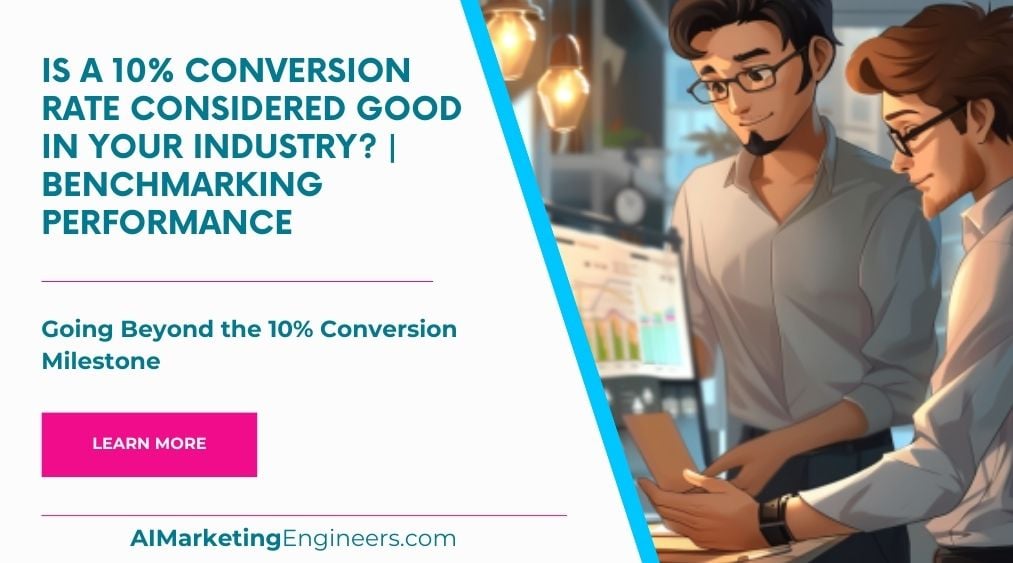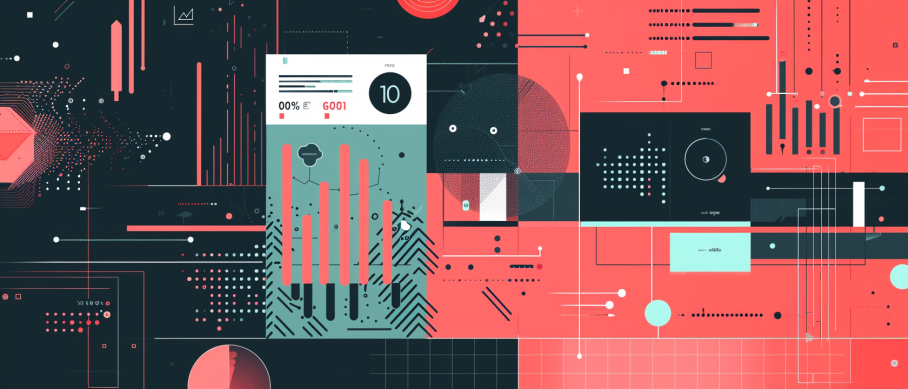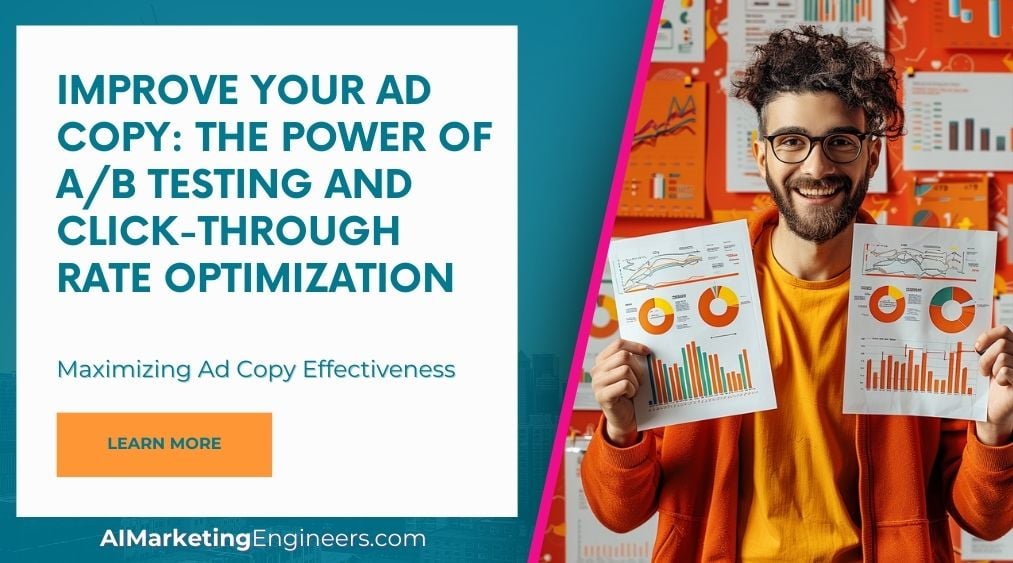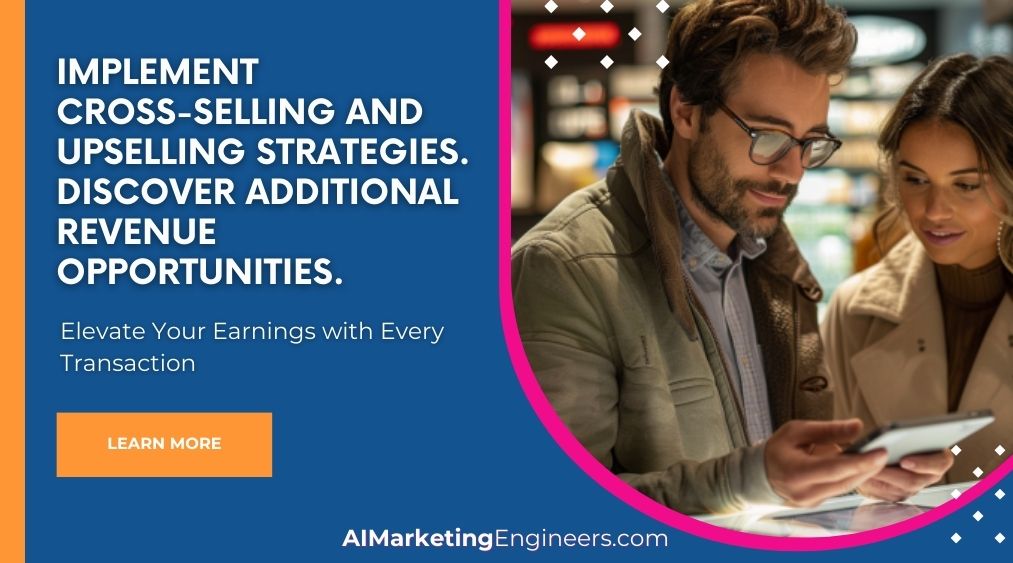Key Takeaways
✅ Conversion Rate Benchmarks Vary by Industry: While a 10% conversion rate might sound impressive, its relevance truly depends on your field. The average for fast-moving consumer goods might hover around a modest 3%, yet other sectors could surpass 10% without breaking a sweat. For an eCommerce platform, elements like traffic sources, cost of items, and purchase types directly affect this metric. Remember, premium goods or subscription services naturally draw in smaller percentage figures.
✅ Internal Benchmarking is Crucial: Don't just peek over the fence at your competitors' numbers. Internal benchmarking—keeping an eagle eye on your own metrics—is where the gold is. By understanding your starting point, recognizing improvement zones, and enacting change, you can carve out robust, customized pathways to better your conversions. This inward focus is indispensable for a tailored fit of attainable and ambitious conversion objectives.
✅ Conversion Rate is Your Pulse: Miss the buzzwords and the fluff; let's get straight to the heart of it—your conversion rate is your business' pulse. A low number? It's a wake-up call for action. And skyrocketing figures? Time for a celebration. But what's that sweet spot, and more importantly, is yours hitting the spot? In the digital marketplace, conversion rates are like the high scores in an arcade, measuring just how well you're turning visitors into buyers.
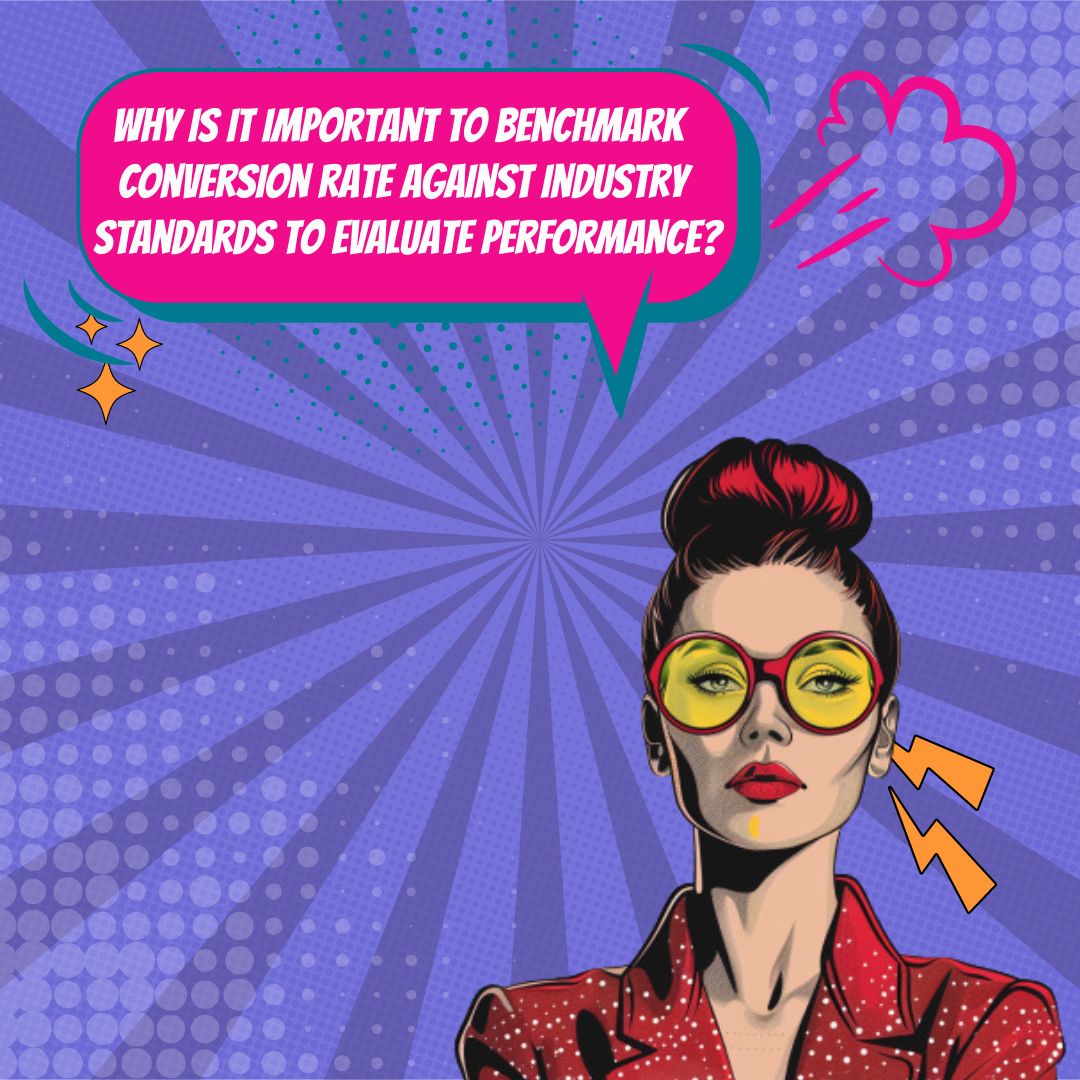
Introduction
Ever wondered if your 10% conversion rate is a cause for a victory lap or just the beginning of the race? In the complex maze of metrics that is benchmarking performance, understanding conversion rates and where you stand can be the difference between thriving and merely surviving. In the whirlwind of digital strategy, businesses often grapple with elusive goals—what’s good enough, and what’s exceptional?
In this era where customer behavior patterns are constantly shifting, having a strong grip on what a conversion rate is and why it matters is not just smart—it's absolutely critical for steering the ship towards greater revenue and solid customer growth. But how well does your conversion stack up against your peers, and what moves should you be making next?
Be prepared to delve into innovative perspectives and untapped solutions that could redefine the way you understand your customers and ultimately, how you drive your business to new heights. Stick with us as we promise to lay down a trail of actionable insights and groundbreaking information that could very well be your roadmap to mastering those conversion rates.

Top Statistics
| Statistic | Insight |
|---|---|
| Global Average Website Conversion Rate: 3.68% | The global benchmark sets realistic expectations for businesses aiming to measure their website's performance. |
| Facebook Conversion Rate: 9.21% | This high figure shows the power of social media in driving consumer actions, possibly making a 10% conversion rate attainable and good for some industries. |
| Email Conversion Rate: 8.93% (click-through rate) | Email remains a strong channel for engagement, suggesting a targeted approach can yield conversion rates close to the ideal 10%. |
| Average Conversion Rate for Paid Search Landing Pages: 2.35% | Compared to other channels, paid search may require more optimization to reach a 10% conversion rate. |
| Automotive and Real Estate Industries: High conversion rate | These sectors often see higher conversion rates due to the nature of their products, which could make a 10% conversion rate a solid benchmark. |
What is a Conversion Rate and Why Does it Matter?
In the bustling world of business, conversion rate is like a trusty gauge on your dashboard, telling you how well your marketing engine is running. It’s a simple enough idea: the conversion rate is the percentage of visitors who take a desired action, whether that’s buying a product, signing up for a newsletter, or any other goal you’ve set. If you're drawing a crowd but no one's buying your ice cream, you’ve got a problem. Significance? It’s about efficiency – the higher your conversion coffee-per-cup rate, the better you’re turning lookers into bookers, and browsers into buyers. This directly impacts the health of your revenue and the efficacy of your customer acquisition strategies. In many ways, it’s about making the most of every visitor who walks through your virtual door.

Industry Benchmarks: What is a Good Conversion Rate?
So what’s a decent score? Well, it's not a one-size-fits-all answer. Every industry has its own benchmarks. Online clothing retailers might see rates around 4%, while e-commerce averages hover around 1-2%. B2B services can expect something in the region of 2-5%, and financial services can see figures upwards of 5%. But wait, it gets trickier. The type of product or service, along with who's buying (your target audience) and how you're reaching them (your marketing strategies), all twist the dial on your conversion rates. Dissecting these benchmarks is crucial to understanding where your own numbers should land.
The 10% Conversion Rate: Is it Good Enough?
A 10% conversion rate is like a high-five in some circles – for landing pages, it's stellar; for email marketing, it’s solid, if not quite spectacular. In sales funnels, it signifies a robust process. But should you set your sights on this number? It's good, without a doubt, but it's not an end-all. Pros include a strong indicator of effective marketing and user engagement. Cons can involve a potential ceiling to quality customer interaction if the aggressive chase for higher percentages overshadows the client experience. How does it fit your scenario? That's the real question.
Factors Affecting Conversion Rates: Identifying Areas for Improvement
Conversion rates don’t operate in a vacuum. They're at the mercy of numerous elements like user experience (UX), which can be a deal-maker if your site is easy and enjoyable to use, or a deal-breaker if it’s clunky and confusing. Content quality is another big hit – if you're answering your visitors' questions and engaging them, they’ll stick around. And let's not forget the power of a call-to-action (CTA) – that little nudge that can make all the difference between an “I’m just browsing” and an “I’ll take that”. It’s these areas where you’ll find the levers to tweak and tune for better performance.

Benchmarking Your Performance: Setting Realistic Goals
Where’s the finish line? Setting realistic conversion rate goals is more art than science. You’ve got to know the lay of the land – the industry averages – and then cross-reference with your own business objectives. Are you sprinting for quick sales, or are you in for a marathon of brand building? Once you’ve set your sights, you can’t just fire and forget. Regular tracking and analysis are critical; they help you see what’s working and fix what isn’t, keeping your strategy sharp and your outcomes on the up and up.
Optimization: Playing the Long Game for Conversion Success
Every click, every view, every purchase is a chapter in your business's ongoing tale. And the plot twist? There's no final chapter. Optimizing conversion rates is an enduring saga of refinement and improvement. It’s not just about hitting a single target but rather, sustaining and growing that success over time. Significant? Absolutely. Because in the grand scheme, it's not just about attracting a crowd. It’s about compelling them to act – and that’s what turns the story of a business into a bestseller.
AI Marketing Engineers Recommendation
Recommendation 1: Understand Industry Standards: To determine if a 10% Conversion Rate is good for your industry, start by gathering industry-specific benchmark data. E-commerce sectors, for example, often have conversion rates hovering between 1% and 2%, according to a 2022 report by IRP Commerce. In contrast, finance and insurance industries may see higher rates, sometimes exceeding 10%. By understanding the average for your niche, you can set more realistic goals and identify areas for improvement.
Recommendation 2: Leverage Segmentation and Personalization: Embrace Customer Segmentation and Personalization strategies to potentially boost your conversion rates higher than the industry average. Current trends indicate a strong customer preference for tailored experiences. Utilize customer data to segment your audience and create personalized marketing campaigns. Salesforce's "State of the Connected Customer" report shows 66% of customers expect companies to understand their needs and expectations, which in turn can translate to higher conversion rates when done correctly.
Recommendation 3: Utilize Conversion Rate Optimization (CRO) Tools: Invest in a robust Conversion Rate Optimization (CRO) Tool such as Optimizely or Unbounce. These platforms offer A/B testing, user feedback, and analytics to improve your website's user experience. A positive user experience is crucial, as a 2021 survey by HubSpot revealed that 93% of customers are likely to make repeat purchases with companies that offer excellent customer service. By fine-tuning your website's design and functionality, you can help ensure visitors stay engaged and are more inclined to convert, potentially raising your conversion rate above the 10% mark.
Relevant Links
- Unleash Your Brand's Full Potential: Mastering SEO on Baidu
- Rise Above the Noise: Proven Strategies for E-Commerce Success in China
- Maximizing Clicks and Sales: The Power of PPC in China's Market
- Amplify Your Online Impact with AI: Revolutionize Your Marketing Strategy
- Scale New Peaks with India's Digital Marketing Playbook
Conclusion
Conversion rates are more than just numbers; they're direct insights into how well your business connects with customers—to what degree people who visit your site or encounter your ads decide to take the plunge and make a purchase, sign up, or perform any other action you deem valuable. Understanding this metric is crucial, as it's directly linked to revenue and the efficacy of your tactics in drawing in new customers.
When we talk about a 10% conversion rate, context is everything. For some industries, such as certain e-commerce niches, this could be a remarkable achievement, well above the usual benchmark. In others, like more conventional retail sectors or B2B enterprises, striving for a 10% conversion rate might be setting the bar incredibly high, possibly to a point that's unrealistic without significant investment in optimization strategies.
While aiming for this rate, remember that factors such as user experience, the clarity of your call-to-actions, and the relevance of content can make or break your conversion odds. The driving force behind your efforts should be continuous improvement—identifying areas where your customer journey can be made more compelling and where your message resonates more strongly.
Benchmarking performance against industry standards offers a grounding point—a way to set realistic goals and measure progress with a clear-eyed view. Yet, don't let benchmarks stifle ambition. Use them as a starting point to refine and elevate your marketing strategies, always with an eye on the ultimate prize: not just more sales, but a stronger connection with the people behind the numbers.
As we gather more data and gain deeper understanding, it's evident that there's no one-size-fits-all answer to whether a 10% conversion rate is "good enough." Your industry benchmarks, business size, and resources play a pivotal role. Nevertheless, aspire to surpass not just the average, but to reach the top percentiles by constantly monitoring, testing, and optimizing. It's in this relentless pursuit of improvement that businesses find sustained success and outperform the competition.

FAQs
Question 1: What is a conversion rate?
Answer: A conversion rate is the proportion of visitors to a website who take the step you're hoping for—it could be buying something, signing up, or filling out a contact form.
Question 2: How is the conversion rate calculated?
Answer: To get your conversion rate, you take the number of conversions and divide it by the total number of visitors you had during a specific time.
Question 3: Why is the conversion rate important?
Answer: Knowing your conversion rate is like having a secret window into how well your website charms visitors into taking action. It shows where you're rocking it and where you might need to spruce things up.
Question 4: What is a good conversion rate for ecommerce?
Answer: "Good" can mean different things depending on what you're selling and who you're selling it to, but generally, hitting around a 10% conversion rate could be cause for a celebration.
Question 5: What is the average conversion rate for the Food and Beverage industry?
Answer: If you're dishing out food and drinks online, an average conversion rate could float anywhere from 1.5% to a tasty 6.2%.
Question 6: How do traffic sources affect conversion rates?
Answer: It's all about where your visitors are coming from. Ads or blogs might not convert as high as your loyal followers or social media pals since newcomers are just getting to know you.
Question 7: How does price point impact conversion rates?
Answer: The more expensive something is, the longer people might mull it over. High price tags usually mean lower conversion rates because we all like to think twice before splurging.
Question 8: How does purchase type affect conversion rates?
Answer: Subscription services often see lower conversion rates compared to one-off purchases. It's all about commitment—people need time to decide if they're in it for the long haul.
Question 9: How can I improve my ecommerce conversion rate?
Answer: If you want more people hitting that "buy" button, sharpen your sales pitch, smooth out the shopping experience, ease those buyer jitters, keep shoppers from ditching their carts, and make sure your store looks great on phones.
Question 10: Why should I benchmark my conversion rate against industry averages?
Answer: Benchmarking lets you know if you're on track or lagging behind. It helps to set real goals, figure out what needs tweaking, and see how you stack up against the competition.
Question 11: How can I educate C-level executives about conversion rate performance?
Answer: Tell your execs a story with data, show them the impact better conversion rates could have, and tie it all to the bottom line to explain why it's worth investing in getting those numbers up.

Academic References
- Ruler Analytics. Conversion Rate Benchmarks by Industry. This study offers an extensive look at average conversion rates across fourteen distinct industries, highlighting the average to be 2.9%. It underlines the disparities that exist based on industry specifics and the value of the product or service in question.
- WordStream. Google Ads Conversion Rates by Industry. This source reports an average conversion rate of 4.40% on Google's search network and 0.57% on the display network. Such data is essential in setting realistic goals and strategies for marketers utilizing Google Ads.
- AudienceView. Importance of Benchmarking Online Conversion Rates for Live Events Organizations. The reported average conversion rate of 12.6% for live events organizations underscores the need for industry-specific benchmarking to gauge performance accurately.
- Capturly. Why Measuring Conversion Rates is Essential. Capturly’s article explains that the measurement of conversion rates is crucial for not just tracking business success but for illuminating areas needing enhancement.
- Capturly. Factors Influencing Conversion Rates. This article sheds light on multiple factors that affect conversion rates including industry type, competition level, product type, customer demographics, traffic source, device usage, location, and pricing aspects.
- Ruler Analytics. Impact of Product/Service Value on Conversion Rates. Emphasizing the influence of the product or service value on conversion rates, the study highlights that higher-value items typically experience lower conversion rates, suggesting that the price is a significant factor in conversion decisions.
